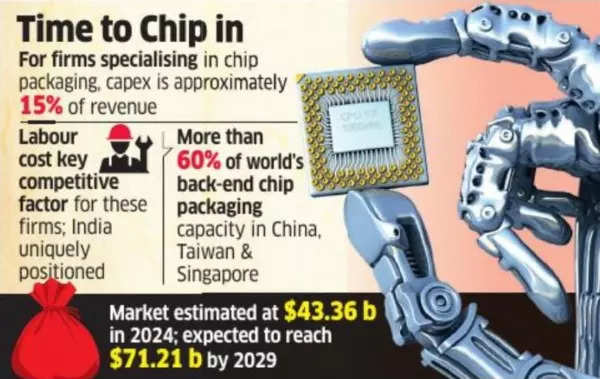[ad_1]
According to an ET report quoting a source, “Tata Electronics has packaged chips there which they are sending to customers right now outside the country. They have multiple partners and are expanding their customer base. Some of these (products) are still in the pilot stage.”
Another person revealed that the company is also close to successfully completing a tape-out of semiconductor chips in various nodes, including 28, 40, 55, and 65 nm, as well as some higher nodes. The tape-out is the final result of the designing process for integrated circuits or printed circuit boards before they are sent for manufacturing.

Semiconductor chips
The person added, “There are multiple rounds before a successful tape-out. So, some of these products will be in advanced stages of R&D and they will be sent to select customers to obtain feedback for testing and improvement. Commercial production is slated for 2027.”
The chips that have been packaged and are currently being exported by Tata Electronics could be used in various products as they have not been designed for a specific purpose. The source explained, “When you package the chips, it really does not matter what the chips are used for. It is just a matter of when you package them and prepare them to be used. Tata Electronics has products in multiple areas.”
In April, the financial daily reported that Tata Electronics had entered into a strategic agreement with Tesla to provide semiconductor chips for the latter’s worldwide operations. However, Tata Electronics did not respond to ET’s inquiries regarding this matter.
According to Neil Shah, vice president at market research firm Counterpoint Research, it is crucial for Tata Group to begin showcasing its chip designing and manufacturing abilities to prospective clients and partners before the fabs are operational in the next 30-36 months. Shah suggested that Tata could leverage its comprehensive expertise and vision from the early semiconductor design development work the company has been engaged in, either through Tata Elxsi, which has collaborations with Renesas and Lattice Semi, or through its internal branch, Sankhya Labs.
Also Read | Apple Awas Yojana? Apple ecosystem to now build residential facilities for workers after creating 1.5 lakh direct jobs
“Tata Electronics should set up solid front-end processes for co-design, testing and quality assurance processes for final production chip tape-outs when the fab is up,” he said. “They must also formulate diligent back-end ATMP processes, services and pilots to achieve global manufacturing standards, lucrative yield rates and become a one-stop shop for both semiconductor design and manufacturing in India.”
The Tata group’s chip foundry in Dholera, established in partnership with Taiwan’s Powerchip Semiconductor Manufacturing Corporation (PSMC), has a planned capacity of up to 50,000 wafer starts per month. The facility is anticipated to manufacture chips in advanced nodes such as 28 nm and 40 nm, as well as some legacy or mature nodes like 55 nm, 90 nm, and 110 nm.
The Tata-PSMC joint venture is set to focus on manufacturing chips in specific nodes before transitioning to the 22 nm segment. Currently, several small and medium-scale packaging companies in India, including Tessolve Semiconductor, CDIL, and SCL, are engaged in similar activities. However, experts suggest that their scale of operations will not match that of larger players like Micron or Tata Group.
In addition to the foundry, Tata Group is also developing an outsourced assembly and testing (OSAT) unit in Assam. This crucial step in the semiconductor value chain involves assembling or packaging wafers produced by semiconductor fabs and testing them before they are used in the final product.
CG Power is also working on a chip assembly and testing unit in Sanand, Gujarat. Other OSAT plants, such as the one announced by the HCL Group-Foxconn group joint venture and another by Hiranandani Group’s Tarq Semiconductors in partnership with Kaynes Technology, are currently awaiting government approval.
[ad_2]
Source link

